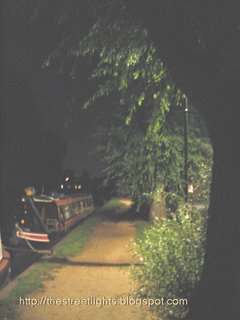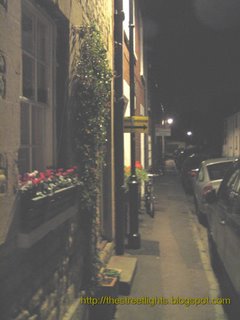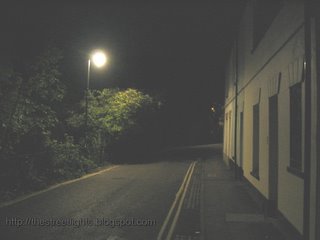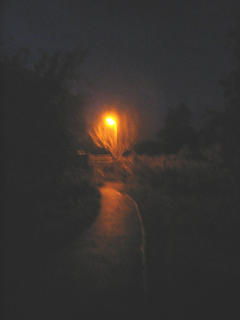
Phwoar! Look at the foliage on that! This verdant view demonstrates the superb colour rendering of Compact Fluorescent street-lighting. Oxford City Council have replaced most of the old monochromatic orange L.P.S. with this type of lighting on West Oxford's residential streets.
We begin a short tour of Osney Island alongside the Thames [none of that "Isis" nonsense here] on East Street, looking south towards Osney Lock.

This view down East Street shows the contrast between white C.F. lighting and the more familiar Dusky Peach of H.P.S. across the river. What looks at first glance to be a mercury-vapour light on a very high column is, in fact, the moon.

Window boxes on West Street. Proper wood-frame sash windows as well! This is great! In fact, I'll bet you want to live here, don't you? Two considerations: 1/ Osney Island
floods. 2/ Despite this inconvenience, a two-bed terraced house here will cost £230-275k. [2005] I humbly suggest part of the reason for this desirability is the superior night-time environment. I know I'd pay a tidy premium for a city-centre location free from ugly sodium lighting.

A final view of West Street, looking towards the Botley Road, which is just visible as a peach-coloured stain in the near-distance. Note: in all these pictures I have tried to represent the actual lighting level, as perceived subjectively at the time of shooting. Flash is never used, as it would defeat my purpose here, which is primarily to show the qualitative differences in the effects of different light-sources on their environments. Therefore, slow shutter-speeds must be used: 0.25-0.8s. Consequently, when, as here, the light-source is included in the photo, it can appear more glaring than it really is. The appearance of a bowl of light in this photo is as a result of light being reflected around in the deep diffuser fitted to these particular "heritage" styled lumieres. The lamp itself is fitted horizontally, high inside the fitment and is not a cause of glare. These compact-fluorescents, whilst providing a slightly higher lighting level than the 35W L.P.S. they have replaced, are nothing like as hard on the eye as the more common H.P.S. The feeling, when walking these streets after dark, is not only one of calm, but also of a re-kindled sense of anticipation for what aesthetic pleasures may be around the next corner.
 It is a FACT that Hell is illuminated by sodium discharge lighting, which, as we all surely know by now, gives VERY POOR colour rendering capability and an unfortunate dusky peach ambience. The muses are repelled and this may well provide an explanation as to why no English word can be found to rhymme with "orange".
It is a FACT that Hell is illuminated by sodium discharge lighting, which, as we all surely know by now, gives VERY POOR colour rendering capability and an unfortunate dusky peach ambience. The muses are repelled and this may well provide an explanation as to why no English word can be found to rhymme with "orange".













